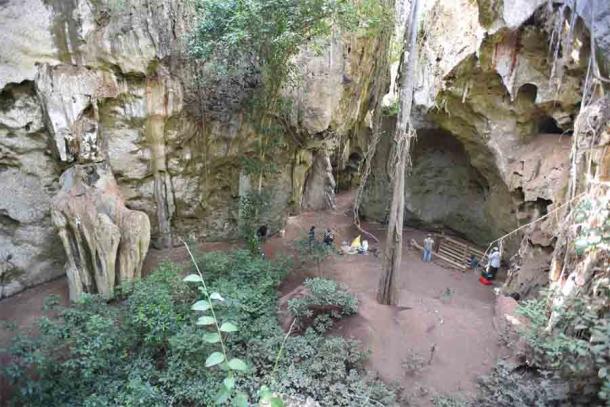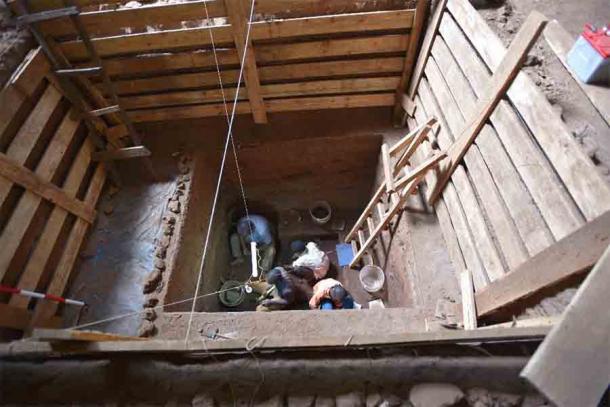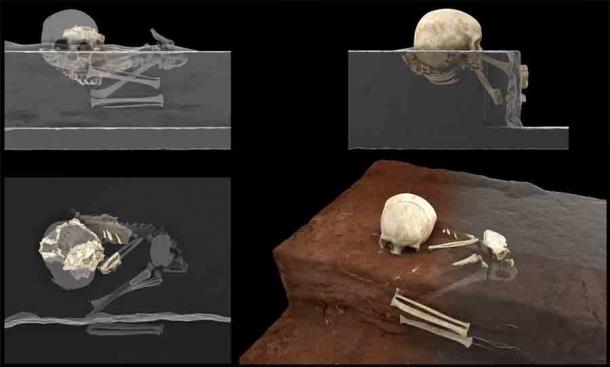78,000 years ago someone buried a young child in a cave. Now, researchers say that child’s grave in Kenya is the earliest known example of a deliberate human burial by modern humans in Africa. The discovery of the child’s grave sheds new light on formal burials and how people treated their dead during Africa’s Middle Stone Age period.
The new study on the earliest human burial in Africa appears in the journal Nature. In the paper, the researchers explain that there are many studies which have focused on the evolution of human behavior in the Middle Stone Age of Africa (which lasted from about 280,000 to 25,000 years ago), but few have explored human behavior in relation to formal burials at that time. This is primarily due to the lack of clear, intentionally made human graves from that time period found on the continent to date.

Virtual ideal reconstruction of Mtoto’s position in the burial pit. (Jorge González/Elena Santos/ Nature)
Finding the Child Grave in the Cave Wasn’t a Straightforward Process
A Nature press release states that María Martinón-Torres of CENIEH (National Research Center on Human Evolution), in Burgos, Spain and her colleagues analyzed the remains of the child which came from Panga ya Saidi, a cave site on the Kenyan coast.

General view of the cave site of Panga ya Saidi. Note trench excavation where the earliest human burial in Africa was unearthed. (Mohammad Javad Shoaee/ Nature)
Archaeologists from the Max Planck Institute (MPI) for the Science of Human History (Jena, Germany) and the National Museums of Kenya (Nairobi) began their excavations at Panga ya Saidi in 2010. Professor Nicole Boivin, principal investigator of that project and director of the Department of Archaeology at the MPI for the Science of Human History, explained how special the site is to the discovery of complex social behaviors in early modern humans. According to a CENIEH press release, Professor Boivin said:
“As soon as we first visited Panga ya Saidi, we knew that it was special. The site is truly one of a kind. Repeated seasons of excavation at Panga ya Saidi have now helped to establish it as a key type site for the East African coast, with an extraordinary 78,000-year record of early human cultural, technological and symbolic activities.”

Trench excavation at Panga ya Saidi. The human burial was found at the bottom of this trench excavation. (Mohammad Javad Shoaee/ Nature)
Although some of the child’s bones were encountered during excavations at the cave in 2013, it wasn’t until 2017 that the full pit for the human burial was fully exposed. The bones were found tightly clustered in the circular pit three meters (9.84 feet) below the cave floor. They were so badly decomposed that they had to be stabilized and plastered on-site.
Dr. Emmanuel Ndiema of the National Museums of Kenya explained that the team was excited, knowing they were on the cusp of a major discovery, “At this point, we weren’t sure what we had found. The bones were just too delicate to study in the field. So we had a find that we were pretty excited about – but it would be a while before we understood its importance,” Dr. Ndiema said in the CENIEH press release.
Revealing Africa’s Earliest Deliberate Human Grave
From there, the cast of the remains went to the National Museum in Nairobi and then the CENIEH. When it arrived in the lab in Burgos, Spain, the fuller image of the importance of this prehistoric human burial came to light through months of hard work.

External view of the Panga ya Saidi main block with the articulated partial skeleton (upper) and external view of the left side of Mtoto’s skull and mandible (below). (Martinón-Torres, et al., 2021/ Nature)
Further excavations, specialized treatments, and analysis of the remains first revealed that the two teeth are modern human ( Homo sapiens ). The dental features also suggest that the remains and the partial skeleton come from a child who died between the ages of 2.5–3 years. Professor María Martinón-Torres described the discoveries in the lab, saying:
“We started uncovering parts of the skull and face, with the intact articulation of the mandible and some unerupted teeth in place. The articulation of the spine and the ribs was also astonishingly preserved, even conserving the curvature of the thorax cage, suggesting that it was an undisturbed burial and that the decomposition of the body took place right in the pit where the bones were found.”
The child, who the team named ‘Mtoto’ (meaning ‘child’ in Swahili), was buried 78,300 years ago on its side with its legs drawn up to its chest. In their paper, the researchers write that Mtoto was buried in a pit that was “deliberately excavated” and that the child’s body had been “covered with sediment rapidly after its placement.” The body apparently decomposed in situ.

Virtual reconstruction of the Panga ya Saidi hominin remains at the site (left) and ideal reconstruction of the child’s original position at the moment of finding (right). (Jorge González/Elena Santos/ Nature)
Perhaps even more astounding is the discovery that the burial may have included some sort of funerary ritual. Martinón-Torres mentioned in the CENIEH press release that “the position and collapse of the head in the pit suggested that a perishable support may have been present, such as a pillow, indicating that the community may have undertaken some form of funerary rite.”
The team also suggests that their may have been something special about the way Homo sapiens were treating their deceased children in that prehistoric time period. In their paper they refer to an infant burial from Border Cave and “the funerary caching” of a juvenile at Taramsa – both intentionally preserved corpses of younger members of their groups – who were interred between 78,000 and 69,000 years ago.
Combining all of these details, the team asserts that this Middle Stone Age human burial was intentional – in fact, the researchers write that this is the earliest known evidence of a deliberate human burial in all of Africa.
How Does the Earliest Burial in Africa Differ from Others?
It’s worth mentioning that although the Panga ya Saidi human burial is the earliest known intentional burial in Africa, other researchers have found Neanderthal and modern human graves – of adults, children, and juveniles – in Eurasia from as far back as 120,000 years ago.
According to the Nature press release, the evidence that the researchers present in their paper demonstrates regional diversity in burial practices because it “suggests that the mortuary behaviours of modern humans in Africa differed from those of Neanderthals and early modern humans in Eurasia.” The researchers propose that the lack of early burials in Africa may demonstrate that difference, or they may just reflect a “lack of field work in large portions of the African continent,” according to the CENIEH press release.
However, Professor Michael Petraglia of the MPI in Jena also explained in the same press release that there are some similarities to be found between human burials and Neanderthal burials:
“The Panga ya Saidi burial shows that inhumation of the dead is a cultural practice shared by Homo sapiens and Neanderthals. This find opens up questions about the origin and evolution of mortuary practices between two closely related human species, and the degree to which our behaviours and emotions differ from one another.”
Finally, the new study adds to the body of research documenting the complex social behaviors of early modern humans. The human burial was located in an archaeological level at the cave which also contained stone tools. Previously, those stone tools have been linked to a variety of hominin species, but the new research provides strong evidence that Homo sapiens were likely the manufacturers of the Middle Stone Age tools.
The study, titled ‘Earliest known human burial in Africa,’ is published in the journal Nature.
Top Image: An artist’s interpretation of Mtoto’s burial. Mtoto’s grave has been named the earliest deliberate human burial in Africa. Source: Fernando Fueyo/ Nature
By Alicia McDermott
Related posts:
Views: 0
 RSS Feed
RSS Feed















 May 6th, 2021
May 6th, 2021  Awake Goy
Awake Goy  Posted in
Posted in  Tags:
Tags: 
















